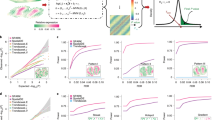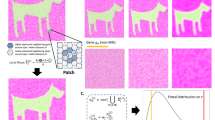Abstract
Recent spatial gene expression technologies enable comprehensive measurement of transcriptomic profiles while retaining spatial context. However, existing analysis methods do not address the limited resolution of the technology or use the spatial information efficiently. Here, we introduce BayesSpace, a fully Bayesian statistical method that uses the information from spatial neighborhoods for resolution enhancement of spatial transcriptomic data and for clustering analysis. We benchmark BayesSpace against current methods for spatial and non-spatial clustering and show that it improves identification of distinct intra-tissue transcriptional profiles from samples of the brain, melanoma, invasive ductal carcinoma and ovarian adenocarcinoma. Using immunohistochemistry and an in silico dataset constructed from scRNA-seq data, we show that BayesSpace resolves tissue structure that is not detectable at the original resolution and identifies transcriptional heterogeneity inaccessible to histological analysis. Our results illustrate BayesSpace’s utility in facilitating the discovery of biological insights from spatial transcriptomic datasets.
This is a preview of subscription content, access via your institution
Access options
Access Nature and 54 other Nature Portfolio journals
Get Nature+, our best-value online-access subscription
$29.99 / 30 days
cancel any time
Subscribe to this journal
Receive 12 print issues and online access
$209.00 per year
only $17.42 per issue
Buy this article
- Purchase on Springer Link
- Instant access to full article PDF
Prices may be subject to local taxes which are calculated during checkout






Similar content being viewed by others
Data availability
Datasets analyzed in this paper are available in raw form from their original authors (see details in the Supplementary Note), and the SingleCellExperiment objects that we prepared for analysis with BayesSpace are available through the BayesSpace package. Raw count matrices, images and spatial data from the IDC sample are accessible on the 10x Genomics website at https://support.10xgenomics.com/spatial-gene-expression/datasets.
Code availability
BayesSpace is available as a Bioconductor package at http://www.bioconductor.org/packages/release/bioc/html/BayesSpace.html, and the source code is publicly available at https://github.com/edward130603/BayesSpace.
References
Ståhl, P. L. et al. Visualization and analysis of gene expression in tissue sections by spatial transcriptomics. Science 353, 78–82 (2016).
Thrane, K., Eriksson, H., Maaskola, J., Hansson, J. & Lundeberg, J. Spatially resolved transcriptomics enables dissection of genetic heterogeneity in stage III cutaneous malignant melanoma. Cancer Res. 78, 5970–5979 (2018).
Berglund, E. et al. Spatial maps of prostate cancer transcriptomes reveal an unexplored landscape of heterogeneity. Nat. Commun. 9, 2419 (2018).
Maynard, K. R. et al. Transcriptome-scale spatial gene expression in the human dorsolateral prefrontal cortex. Nat. Neurosci. 24, 425–436 (2021).
Janosevic, D. et al. The orchestrated cellular and molecular responses of the kidney to endotoxin define a precise sepsis timeline. eLife 10, e62270 (2021).
Saiselet, M. et al. Transcriptional output, cell types densities and normalization in spatial transcriptomics. J. Mol. Cell Biol. 12, 906–908 (2020).
Lubeck, E., Coskun, A. F., Zhiyentayev, T., Ahmad, M. & Cai, L. Single-cell in situ RNA profiling by sequential hybridization. Nat. Methods 11, 360–361 (2014).
Chen, K. H., Boettiger, A. N., Moffitt, J. R., Wang, S. & Zhuang, X. Spatially resolved, highly multiplexed RNA profiling in single cells. Science 348, aaa6090 (2015).
Rodriques, S. G. et al. Slide-seq: a scalable technology for measuring genome-wide expression at high spatial resolution. Science 363, 1463–1467 (2019).
Hu, K. H. et al. ZipSeq: barcoding for real-time mapping of single cell transcriptomes. Nat. Methods 17, 833–843 (2020).
Gavin, J. & Jennison, C. A subpixel image restoration algorithm. J. Comput. Graph. Stat. 6, 182–201 (1997).
Ripley, B. D. The use of spatial models as image priors. In Spatial Statistics and Imaging: Papers from the Research Conference on Image Analysis and Spatial Statistics held at Bowdoin College, Brunswick, Maine, Summer 1988 20, 309–340 (Institute of Mathematical Statistics, 1991).
Tipping, M. E. & Bishop, C. M. Bayesian image super-resolution. In Proc. 15th Int. Conf. Neural Information Processing Systems (eds. Becker, S., Thrun, S. & Obermayer, K.) 1303–1310 (2002).
Andersson, A. et al. Single-cell and spatial transcriptomics enables probabilistic inference of cell type topography. Commun. Biol. 3, 565 (2020).
Cable, D. M. et al. Robust decomposition of cell type mixtures in spatial transcriptomics. Nat. Biotechnol. https://doi.org/10.1038/s41587-021-00830-w (2021).
Elosua-Bayes, M., Nieto, P., Mereu, E., Gut, I. & Heyn, H. SPOTlight: seeded NMF regression to deconvolute spatial transcriptomics spots with single-cell transcriptomes. Nucleic Acids Res. https://doi.org/10.1093/nar/gkab043 (2021).
Zhu, Q., Shah, S., Dries, R., Cai, L. & Yuan, G. C. Identification of spatially associated subpopulations by combining scRNAseq and sequential fluorescence in situ hybridization data. Nat. Biotechnol. 36, 1183–1190 (2018).
Dries, R. et al. Giotto: a toolbox for integrative analysis and visualization of spatial expression data. Genome Biol. 22, 78 (2021).
Pham, D. T. et al. stLearn: integrating spatial location, tissue morphology and gene expression to find cell types, cell–cell interactions and spatial trajectories within undissociated tissues. Preprint at bioRxiv https://doi.org/10.1101/2020.05.31.125658 (2020).
Besag, J. On the statistical analysis of dirty pictures. J. R. Stat. Soc. Ser. B 48, 259–279 (1986).
Gottardo, R., Besag, J., Stephens, M. & Murua, A. Probabilistic segmentation and intensity estimation for microarray images. Biostatistics 7, 85–99 (2006).
Amezquita, R. A. et al. Orchestrating single-cell analysis with Bioconductor. Nat. Methods 17, 137–145 (2020).
Fraley, C., Raftery, A. E. & Murphy, T. B. mclust version 4 for R: normal mixture modeling for model-based clustering, classification, and density estimation. R. J. 8, 289–317 (2012).
Blondel, V. D., Guillaume, J. L., Lambiotte, R. & Lefebvre, E. Fast unfolding of communities in large networks. J. Stat. Mech. Theory Exp. 2008, P10008 (2008).
Kiselev, V. Y. et al. SC3: consensus clustering of single-cell RNA-seq data. Nat. Methods 14, 483–486 (2017).
Wang, H. X. et al. HSPB1 deficiency sensitizes melanoma cells to hyperthermia induced cell death. Oncotarget 7, 67449–67462 (2016).
Mathieu, V. et al. The sodium pump α1 sub-unit: a disease progression-related target for metastatic melanoma treatment. J. Cell. Mol. Med. 13, 3960–3972 (2009).
Tirosh, I. et al. Dissecting the multicellular ecosystem of metastatic melanoma by single-cell RNA-seq. Science 352, 189–196 (2016).
Mori, K. et al. CpG hypermethylation of collagen type I α 2 contributes to proliferation and migration activity of human bladder cancer. Int. J. Oncol. 34, 1593–1602 (2009).
Knudsen, E. S. et al. Progression of ductal carcinoma in situ to invasive breast cancer is associated with gene expression programs of EMT and myoepithelia. Breast Cancer Res. Treat. 133, 1009–1024 (2012).
Lee, S. et al. Differentially expressed genes regulating the progression of ductal carcinoma in situ to invasive breast cancer. Cancer Res. 72, 4574–4586 (2012).
Hu, M. et al. Regulation of in situ to invasive breast carcinoma transition. Cancer Cell 13, 394–406 (2008).
Hattrup, C. L. & Gendler, S. J. MUC1 alters oncogenic events and transcription in human breast cancer cells. Breast Cancer Res. 8, R37 (2006).
Besmer, D. M. et al. Pancreatic ductal adenocarcinoma mice lacking mucin 1 have a profound defect in tumor growth and metastasis. Cancer Res. 71, 4432–4442 (2011).
Behrens, M. E. et al. The reactive tumor microenvironment: MUC1 signaling directly reprograms transcription of CTGF. Oncogene 29, 5667–5677 (2010).
Zhang, X. et al. Insights into the distinct roles of MMP-11 in tumor biology and future therapeutics (Review). Int. J. Oncol. 48, 1783–1793 (2016).
Holland, D. G. et al. ZNF703 is a common luminal B breast cancer oncogene that differentially regulates luminal and basal progenitors in human mammary epithelium. EMBO Mol. Med. 3, 167–180 (2011).
Sircoulomb, F. et al. ZNF703 gene amplification at 8p12 specifies luminal B breast cancer. EMBO Mol. Med. 3, 153–166 (2011).
Daly, R., Binder, M. & Sutherland, R. Overexpression of the Grb2 gene in human breast cancer cell lines. Oncogene 9, 2723–2727 (1994).
Tari, A. M., Hung, M. C., Li, K. & Lopez-Berestein, G. Growth inhibition of breast cancer cells by Grb2 downregulation is correlated with inactivation of mitogen-activated protein kinase in EGFR, but not in ErbB2, cells. Oncogene 18, 1325–1332 (1999).
Onichtchouk, D. et al. Silencing of TGF-signalling by the pseudoreceptor BAMBI. Nature 401, 480–485 (1999).
Ji, A. L. et al. Multimodal analysis of composition and spatial architecture in human squamous cell carcinoma. Cell 182, 497–514 (2020).
Sümer, C., Boz Er, A. B. & Dinçer, T. Keratin 14 is a novel interaction partner of keratinocyte differentiation regulator: receptor-interacting protein kinase 4. Turk. J. Biol. 43, 225–234 (2019).
Liu, W. Unsupervised learning approaches for the finite mixture models: EM versus MCMC. In 2010 International Conference on Cyber-Enabled Distributed Computing and Knowledge Discovery 2010, 498–501 (IEEE, 2010).
Lun, A. T. L., Bach, K. & Marioni, J. C. Pooling across cells to normalize single-cell RNA sequencing data with many zero counts. Genome Biol. 17, 75 (2016).
McCarthy, D. J., Campbell, K. R., Lun, A. T. L. & Wills, Q. F. Scater: pre-processing, quality control, normalization and visualization of single-cell RNA-seq data in R. Bioinformatics 33, 1179–1186 (2017).
Gelman, A., Roberts, G. O. & Gilks, W. R. Efficient Metropolis jumping rules. Bayesian Stat. 5, 599–607 (1996).
Chen, T. & Guestrin, C. XGBoost: a scalable tree boosting system. In Proceedings of the ACM SIGKDD International Conference on Knowledge Discovery and Data Mining 785–794 (Association for Computing Machinery, 2016).
Stuart, T. et al. Comprehensive integration of single-cell data. Cell 177, 1888–1902 (2019).
Izar, B. et al. A single-cell landscape of high-grade serous ovarian cancer. Nat. Med. 26, 1271–1279 (2020).
Acknowledgements
This research was supported by funding from the National Institutes of Health (P01-CA225517, P30-CA015704 to R.G. and P.N.; T32-CA080416, F30-CA254168 to T.P.), the Immunotherapy and Data Science Integrated Research Centers at Fred Hutchinson to E.Z., M.R.S., X.R. and J.H.B. and the Scientific Computing Infrastructure at Fred Hutchinson funded by ORIP grant S10OD028685. We thank M. Lin and P.L. Porter for their pathological review of J.G.’s histological annotations, K.J. Cheung from the Fred Hutchinson Public Health Sciences and Human Biology Divisions for his suggestions in our analysis of the IDC sample, A. Moshiri from the UW Division of Dermatology for his review of T.P.’s histopathological annotations and Q. Nguyen and X. Tan at the University of Queensland for their assistance in applying stLearn.
Author information
Authors and Affiliations
Contributions
E.Z. and R.G. formulated the method and wrote the paper. M.R.S. and E.Z. developed software. E.Z., M.R.S. and X.R. analyzed data. J.G., K.S.S. and T.P. contributed to annotation and interpretation of cancer samples. C.R.U., S.R.W. and S.E.B.T. prepared and contributed to analysis of the IDC sample. P.N., J.H.B. and R.G. supervised the project.
Corresponding author
Ethics declarations
Competing interests
R.G. has received consulting income from Juno Therapeutics, Takeda, Infotech Soft, Celgene and Merck, has received research support from Janssen Pharmaceuticals and Juno Therapeutics and declares ownership in Ozette Technologies and stock ownership in 10x Genomics. S.R.W., C.R.U. and S.E.B.T. are employees of and hold shares in 10x Genomics. All other authors declare no conflicts of interest.
Additional information
Peer review information Nature Biotechnology thanks the anonymous reviewers for their contribution to the peer review of this work.
Publisher’s note Springer Nature remains neutral with regard to jurisdictional claims in published maps and institutional affiliations.
Supplementary information
Supplementary Information
Supplementary Note, Figs. 1–23 and Table 1
Rights and permissions
About this article
Cite this article
Zhao, E., Stone, M.R., Ren, X. et al. Spatial transcriptomics at subspot resolution with BayesSpace. Nat Biotechnol 39, 1375–1384 (2021). https://doi.org/10.1038/s41587-021-00935-2
Received:
Accepted:
Published:
Issue Date:
DOI: https://doi.org/10.1038/s41587-021-00935-2
This article is cited by
-
Multiomics characterization of pyroptosis in the tumor microenvironment and therapeutic relevance in metastatic melanoma
BMC Medicine (2024)
-
Multi-slice spatial transcriptome domain analysis with SpaDo
Genome Biology (2024)
-
Evaluating spatially variable gene detection methods for spatial transcriptomics data
Genome Biology (2024)
-
Unsupervised spatially embedded deep representation of spatial transcriptomics
Genome Medicine (2024)
-
Unsupervised and supervised discovery of tissue cellular neighborhoods from cell phenotypes
Nature Methods (2024)



